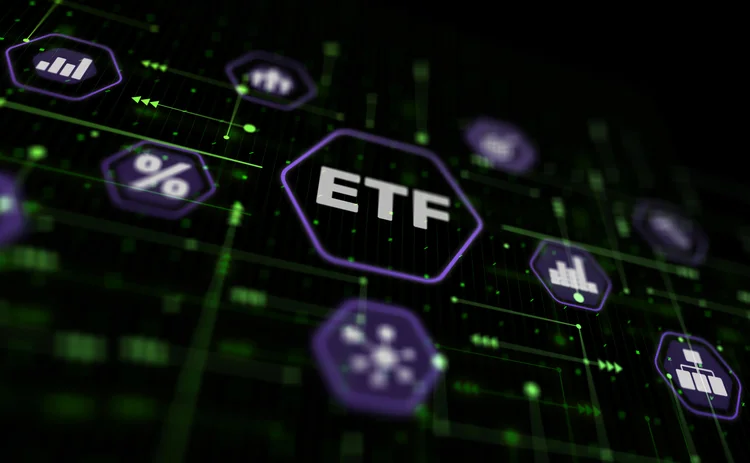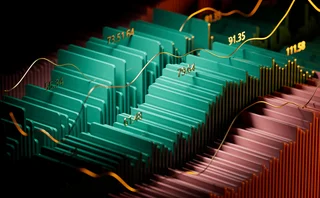Can exchanges leverage new tech to claw back ETF share from RFQ platforms?
Systematic trading strategies and proliferating data are bringing efficiency to an otherwise-fragmented European ETF market.

Automation and data-driven protocols are gaining ground in European exchange-traded fund trading, helping traders to negotiate a fragmented product and liquidity landscape, according to speakers at industry conference TradeTech Europe.
The rise of retail trading, increasing global volatility, and the success of the Ucits format—an EU framework aimed at ensuring that funds have diversified holdings—have all contributed to ETFs becoming more popular investments in Europe. The European ETF market is forecast to grow by 15% annually for the next five years, according to research by consultancy EY.
On one panel at the conference, Tim Miller, senior trader at Fidelity International, said that technological developments are adding to the allure of Europe’s ETF markets.
“I certainly don’t believe we’re at peak ETF. Nowhere near. I think we’re at an inflection point now, where technology is coming to the forefront to create solutions to a lot of the problems that are built into the European ETF ecosystem,” he said, citing new trading protocols and the rise of algorithmic trading usage in ETF markets.
European ETFs have $1.8 trillion in assets under management. But liquidity is dispersed across more than 2,500 funds, and half of European ETFs trade less than 10 times per day. As a result, request-for-quote-based (RFQ) platforms that execute off-exchange, such as Tradeweb and Bloomberg, enjoy the most popularity among ETF trading venues, offering greater competition and reduced risk of information leakage. According to analysis by Jane Street cited in a panel discussion, RFQ platforms now account for more than half of ETF trading in Europe.
RFQ platforms have begun expanding list trading capabilities, and rolling out portfolio trading and notional trading, allowing market participants to trade ETFs based on the monetary value they are prepared to transact, rather than a specific number of shares.
Adam Gould, global head of equities at electronic trading platform Tradeweb, says the RFQ process for ETFs has changed significantly over the past decade. Where the original RFQ mechanism involved investors messaging traders through a chat function to request a certain fund, the entire process can now be automated—including setting the parameters of the trade, the dealers who are invited to participate, and even the time of the transaction.
“It’s a hot topic for multiple reasons. Buy-side traders are being asked to do more with less, and the number of trades continues to increase. Anything that can be automated is well received,” Gould tells WatersTechnology.
With this massive growth we’re going to see in ETFs, there’s going to be more small tickets, and I think algos will play a very key role as we grow
Ben Miller, Citigroup
In March, 86.1% of European ETF trades on Tradeweb were automated. In terms of notional value, however, that figure was closer to 20%, showing that traders still want a hand in the larger-value trades. But Gould is optimistic that the bigger trades will also be automated once market participants get used to using automated protocols.
“Over time, we’re seeing these firms shift their parameters on the automated trading, with higher-value trades qualifying for the automated process as they trust it more and see it works well,” he says.
Another significant innovation in ETF trading is the introduction of algorithms by brokers, typically coming from the equities space. Traders on TradeTech Europe’s ETF panels agreed that ETF algos are now usable and can benefit the market.
Ben Miller, vice president of ETF specialist sales for Europe, the Middle East and Africa at Citigroup, believes that ETF algos will receive a boost from regulations such as CSDR and T+1, which put increased emphasis on a robust post-trade process. Currently, Miller told the audience at TradeTech, only 25% of ETF trading volumes are executed by algos, compared to 86% for cash equities.
Another factor helping to close that gap will be the increase in small tickets driven by retail participation in ETF markets. Currently, 30% of ETF trading activity seen by Citi is comprised of trades worth less than $1 million.
“I think with this massive growth we’re going to see in ETFs, there’s going to be more small tickets, and I think algos will play a very key role as we grow,” Citi’s Miller said.
Exchanges are also trying to get in on the action. European venues, including SIX Swiss Exchange, LSE Group, Deutsche Börse, and Euronext Milan have introduced on-exchange RFQ options for ETF trading, allowing market participants to have their trades printed on exchange while using an RFQ mechanism.
David Smith, head of ETF sales at SIX Swiss Exchange, said on the TradeTech panel that 35% of all passive ETF turnover on the exchange in Q1 this year was from non-proprietary firms. “We are starting to see a different dynamic in the order book, and more natural buyers and sellers are willing to rest passively. And that, to me, is evidence that there’s a lot more ETF algo flow coming to the market,” Smith said.
A spokesperson for SIX Swiss Exchange told WatersTechnology that in January 2024, average users who were passive in the book could save more than six basis points of the spread.
But with the market share of RFQ continuing to grow, the place of the ‘E’ in ‘ETF’ is still in question. Speakers on multiple panels at TradeTech raised the possibility of a trade-through rule in Europe, driving more order flow onto exchanges by requiring RFQ platforms to sweep trades outside the exchanges’ bid/ask spread onto lit order books. Panelists cautioned that this would come with significant technical complexity in Europe’s heavily fragmented market, increasing the need for messaging between venues and requiring functions that can handle both RFQ and displayed orders.
For the most part, however, the tone was upbeat. The surging popularity of ETFs in the US is being helped by the SEC’s approval of bitcoin ETFs, while a vogue for actively managed funds has fueled optimism that European ETF markets are also set to enjoy higher volumes. More participation in the market brings more data, which enables further automation.
“All of these little bits of the jigsaw are now coming together, and it really does feel like a leap for the industry in the last 10–15 years,” said Fidelity International’s Miller. “It feels like we’re almost at that next step where we are going to have some really efficient markets.”
Further reading
Only users who have a paid subscription or are part of a corporate subscription are able to print or copy content.
To access these options, along with all other subscription benefits, please contact info@waterstechnology.com or view our subscription options here: http://subscriptions.waterstechnology.com/subscribe
You are currently unable to print this content. Please contact info@waterstechnology.com to find out more.
You are currently unable to copy this content. Please contact info@waterstechnology.com to find out more.
Copyright Infopro Digital Limited. All rights reserved.
As outlined in our terms and conditions, https://www.infopro-digital.com/terms-and-conditions/subscriptions/ (point 2.4), printing is limited to a single copy.
If you would like to purchase additional rights please email info@waterstechnology.com
Copyright Infopro Digital Limited. All rights reserved.
You may share this content using our article tools. As outlined in our terms and conditions, https://www.infopro-digital.com/terms-and-conditions/subscriptions/ (clause 2.4), an Authorised User may only make one copy of the materials for their own personal use. You must also comply with the restrictions in clause 2.5.
If you would like to purchase additional rights please email info@waterstechnology.com
More on Trading Tech
Recent volatility highlights tech’s vital role in fixed income pricing
MarketAxess’ Julien Alexandre discusses how cutting-edge technology is transforming pricing and execution in the fixed income market amid periodic bouts of volatility
Banks fret over vendor contracts as Dora deadline looms
Thousands of vendor contracts will need repapering to comply with EU’s new digital resilience rules
Where have all the exchange platform providers gone?
The IMD Wrap: Running an exchange is a profitable business. The margins on market data sales alone can be staggering. And since every exchange needs a reliable and efficient exchange technology stack, Max asks why more vendors aren’t diving into this space.
This Week: Trading Technologies completes ANS deal; State Street; Equinix; and more
A summary of the latest financial technology news.
Interactive Brokers looks beyond US borders for growth opportunities
As retail trading has grown in volume and importance, Interactive Brokers and others are expanding international offerings and marketing abroad.
JP Morgan’s goal of STP in loans materializes on Versana’s platform
The accomplishment highlights the budding digitization of private credit, though it’s still a long road ahead.
As data volumes explode, expect more outages
Waters Wrap: At least for those unprepared—though preparation is no easy task—says Anthony.
This Week: ICE Bonds and MarketAxess plan to connect liquidity networks, TS Imagine, Bloomberg, and more
A summary of the latest financial technology news.








